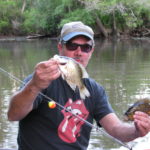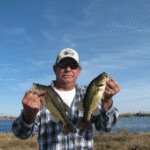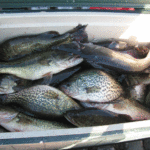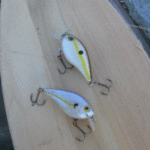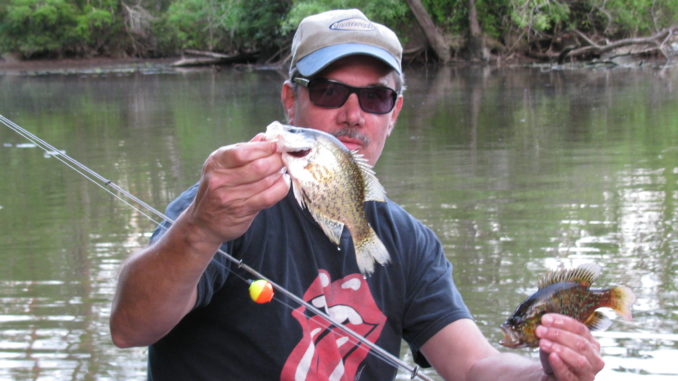
It’s not grain but fish that draw Northshore anglers to this annual hotspot.
Eddie’s “paaaw-ty barge” was aptly named already, but festooned in red, white and green and filled with green-clad revelers for the Irish-Italian boat parade on the Lower Tchefuncte River — well, the USS Paaaw-ty Barge was really strutting her stuff that afternoon.
“Told ya the adjustable legs on my tripod stand would come in handy!” yelled the parade’s beaming “Grand Marshall” Eddie from his towering throne. Pelayo looked up and laughed from the helm, which he’d just taken over as designated driver. His antibiotic prescription made him perfect for the task.
And — indeed — Pelayo grabbed the wheel just in time to smack into a jet-ski wake. “Aeeeh!” screamed Trisha while grabbing the railing for dear life and sending her Pete’s Special all over my neck. Priscilla’s Bloody Mary went overboard, and she was halfway over the railing when Chris grabbed her tightly around the waist for the “rescue” (winking maliciously as his grip lingered long, LONG after the “rescue”).
The entire remainder of this famous parade (one bay-boat carrying Doc, Artie, Nick, Spence and their wives) also smacked the wake (in this multi-flagged “NO-WAKE ZONE”) with similar results.
Eddie roared hysterically from his “throne.” He’d seen the wake coming before any of us and held on tightly for the “SMACK!” against it.
“PUNKS!” he yelled at the departing jet-ski. ‘We’ll get you! It ain’t over — just watch!”
The jet-skiers, along with the occupants in five other boats around us, all yelled their salutations at “Grand Marshall” Eddie. And who can blame them? Chances are they’d never seen a deer tripod stand fitted onto a party barge. Granted, Eddie had adjusted the legs to where it towered only 10 feet over the surface of the Tchefuncte River instead of the normal 20 it towers over the briars and brambles in the 5-year-old clearcut where it usually stands on his lease. And instead of the normal camo wrapping around the swivel seat, it was now wrapped in Italian and Irish flags.
This altitude put it right at the level of some of the captains on the yachts in the area — and after yelling at the jet-skiers, Eddie looked left at one such, and took full advantage of the setting.
“Howze about some babe swapping?” Eddie yelled pointing his Hurricane cup at the females on the yacht’s bow. “We got plenty!” he added, while pointing around him. “And looks like y’all got plenty! So let’s rollll!”
Instead of replying, the neighboring helmsman frowned and grabbed his radio, probably calling the St. Tammany Sheriff’s patrol.
As is usual every 15 minutes on pretty weekend afternoons, the Madisonville draw-bridge over the Tchefuncte was open, making way for a mini-parade of boats. Though far behind them, it looked like we’d pass too. Then….
“Look!” yelled Priscilla while pointing ahead. “The bridge is coming down!”
“We got it!” whooped Eddie. “Hit the gas, Pelayo! Gun it! We can make it.”
“We’re in a NO-WAKE zone, Eddie!” Pelayo roared back. “Cool your jets, man! We got plenty time. What’s the hurry? The evening’s young!”
“GUN IT!” Eddie replied while waving his cap and yelling maniacally. “YOOOO-HA! — EEEE–HA!”— “YOOOO-HA! —EEEE–HA!”
Remember Slim Pickens as “Major Kong” riding the bomb down at the end of Dr. Strangelove? Eddie loves that scene. And here he had Slim down pat. If Pelayo followed his advice, it was Eddie, of course, who’d end up much like Major King Kong at the end of his bomb ride. He’d be the one decapitated.
Eddie’s Grandad had bought “a week-end house across da lake on the Sha-funk-ta” several decades before the phrase “waterfront property on the Northshore” came into vogue. He bought it for about what a two-bedroom shotgun in Lakeview goes for nowadays. After his second disbarment and divorce, Eddie decided it made a nice domicile, to say nothing of “Paaawty Central” for the gang whenever Doc’s condos proved unavailable. The place also serves as an ideal base of operations for weekends featuring leisurely pan-fishing trips in the Madisonville “rice-field” area, followed by a fish-fry, heavy on “green-trout” fillets — crunchy golden brown on the outside, luscious and juicy on the inside.
“You can’t hardly overcook green trout,” says Eddie’s dad, Mr Henry. “Get distracted while getting another beer, or arguing about Les Miles while frying catfish or specks, and they can get dry on ya. But green trout and sac-a-Lait are more forgiving in this department. They almost never get tough or dry.”
No one argues with Mr Henry, especially after inhaling half a dozen of his delicious fried green-trout fillets.
Needless to add, “green trout” and “across da lake” have long given way to “bass” and “Northshore” — but not with this gang.
“Why rice fields?” I once asked legendary fishing guide Capt. Mack Raiford, who was born and raised in the area. “I mean, everybody calls them that, but the area doesn’t look much like Gueydan or Jennings to me. Looks more like a typical flotant swamp like you see around Lakes Salvador, Bouef and northern Maurepas.”
“Here’s the deal, Hom-Boy-Da,” replied the legendary captain. “The levee-enclosed marsh you see west of the Tchefuncte and east of Port Louis Road (Guste Island Road) was an area of actual rice fields probably up until the 1930s. I grew up fishing them a little later, In the ’50s and ‘60s. Filling buckets with green trout, lakerunners, bream, goggleye, using nothing more than worms and shiners and grass shrimp. And the amazing thing about this area is that its still pretty much like it was when I grew up. I mean you can still fill a box with green trout and panfish in that area with basically the same baits I was using back then.
“Now when I’m targeting green trout, I always use the Rebel minnow — cast it over some structure in those canals, twitch it — and WHAM! I’m still doing it!”
This shallow marsh warms up pretty quickly, explains Calvin Hills, a Madisonville fishing aficionado who seems to fill a box with panfish on every trip to this network of canals.
“I do real good around here all through late winter and early spring, Hom-Doy-Da,” he said. “But when it starts getting super hot around May, I move over to the Tickfaw and other deeper flowing streams, where the green trout and sac-a-lait seem to turn on a little later.”
Indeed, in our experience the best panfishing in the Pearl River system, for example, peaks much later than it does in the shallow Madisonville marsh, around June, when the water’s finally down, clearing up and warming up. That’s when the bluegill, lakerunners, cats and yellow bass go into their feeding frenzies.
The upper Tchefuncte, Bogue Chitto and Tangipahoa turn on a little earlier, mid to late May, at least in our experience. Not that you won’t catch good numbers of panfish a little earlier and a little later. It’s just that they’re more predictable in early summer.
But the shallow marshes in the Madisonville area seem to turn on much earlier. Also, the variety of fish in this area has a lot to do with its predictability. Lakerunners, bluegill, yellow bass, channel cats, blue cats, goggleye, sac-a-lait and the ever-abundant green-trout. If one species isn’t “turned on” or “running,” for any of their number of unfathomable reasons, a couple of the others usually take up the slack.
Structure is the key around here for much of the great panfishing, explains Raiford.
“I can show you pictures of the Madisonville Lighthouse from the 1920s, and the backdrop is a thick swamp of cypress trees,” he said. “That was all logged out, but the stumps remained. And they’re still down there providing ideal cover for all kinds of panfish.”
These overflow or tidal swamp settings always produce top-notch panfishing for the simple reason that they provide the most food and cover for panfish, especially food. The very eastern edge of what you can still call the extended Maurepas Swamp, peters out right here in Madisonville. This swamp is a breeding ground for an enormous buffet of insects, crustaceans, snails, frogs, salamanders, worms — you name it.
So the water comes up, overflows into that flooded swamp, and the panfish have a feast. The water starts dropping, and this buffet channels into the canals through the network of little bayous, sloughs and trenasses. You don’t find this phenomenon in completely land-locked ponds or lakes or creeks or rivers.
Pelayo prevailed at the Madisonville bridge, foiling Eddie’s kamikaze run. So the next morning, we piled into Eddie’s flatboat, headed downriver and took a right at what some call the “High-Bridge Canal” and the more tradition-minded still call the “Pine Island Canal. “
“Tides dropping,” Pelayo nodded. “Looks good.”
About a mile and a half down, we turned left into a deep dead- end slough and trolled along the cypress-studded bank.
I was threading on two grass shrimp while Eddie baited up with a shiner and Pelayo, the purist, started casting his little silver crankbait. Eddie and I were fishing about four feet deep under little corks. Say what you want, but day in and day out, there’s just no topping grass shrimp for this type of fishing. Worms often work as well. Crickets work too. But they don’t yield the variety of fish that grass shrimp entice.
“That’s what I love about grass shrimp,” Hills said. “Ain’t no telling what ya gonna catch on ‘em, Hom-Boy-Da. EVERYTHING likes ‘em! I’ll put one or two on a plain hook about 4 feet under the little cork. This time of the year, I like to fish a little deep. Or my specialty: I’ll sweeten up a white and green or clear mini-jig with a live grass shrimp. Just like ya might sweeten up a shad-rig, beetle or Cocahoe for saltwater with maaaw-ket shrimp, ya unnerstan, Hom-Boy-Da?
“Then I cast. Well first cast might be a nice lakerunner, the next and it’s a goggleye, the next it’s a catfish and the following two bring up a sac-a-lait and a green trout. Around here it’s a mixed bag of delicious panfish on every trip.
“But that ain’t the only bait I use, Hom-Boy-Da. Man! When I see those shiners just blowing up — blowing up along these canals, especially in the cuts, well I know there’s bass under them. That’s when I cast out my crankbait. I like a small silver colored one to mimic the shiners, especially this time of year, when the grass and weeds haven’t really clogged up the canals so the two treble hooks don’t usually snag much.”
After repeatedly studying the stomach contacts of green trout in this area, I see Raiford and Hills’ point on their choice of little silver crankbaits and the Rebel minnow. The green trout in this tidal marsh are more shiner-eaters than crawfish or frog eaters.
“Holy moly!” Eddie yelled as he cranked away after his cork plunged next to a cypress knee.
“He ain’t jumping, Eddie,” Pelayo noticed. “Probably a …”
“Check out the size of this sac-a-lait!” Eddie yelled in triumph as the fish flopped boatside.
“Here!” I yelled. “Let me get the net! Ya sure don’t wanna lose that sucka!”
My cork plunged next, and this one DID jump.
“Green trout coming up!” I announced. “No need for the net.”
Eddie and I had six fish (two sacs, two green trout, one lakerunner and one goggleye) in the boat, and Pelayo was still casting futilely with his little silver crankbait.
“Let’s crank it up,” he complained, and we moved farther down the High Bridge and turned right (north). Soon we hit a wash where the water was emptying from the marsh.
“LOOK!” Pelayo yelled. “Check out the shiners. Just like Calvin said!”
And he cast his little crankbait well past them.
Indeed little schools of shiners were erupting. Predators were obviously below.
“A no-brainer!” Pelayo yelled mid-way into his retrieve. Then the little green trout jumped. Eddie and I were soon casting, with a shiner and a shrimp-sweetened mini-jig respectively.
It didn’t take long till another bass and a chunky goggleye were flopping in the box, which was sure looking pretty. We trolled along the canals, fishing fairly deep (4 feet) casting near the stumps and steadily filling the box. The bass favored the crankbait and shiners. The sacs favored shiners and mini jigs. And the lakerunners, goggleye, bluegill and channel cats inhaled the grass shrimp.
No rocket science involved here, amigos. We ended up with 34 gorgeous (to us) panfish that made for an absolutely killer fish-fry (including po-boys with homemade tartar sauce) at “Paaawty Central” that night.
